May 1995
Please note:
See our January 2007
publication,
California’s Criminal Justice System: A Primer, which provides updated data
related to the juvenile justice system as well as answers to the following
questions: Who Are Juvenile Offenders? How Prevalent Is Juvenile Crime in
California? What Happens to Juvenile Offenders? It also discusses (a) reforming
the division of juvenile justice and (a) defining state and local
responsibilities for juvenile offenders.
Juvenile Crime--Outlook for California
Part V
Goals of the Juvenile Justice System. Both California's adult and juvenile justice systems have as one of their goals public safety. California's adult system also has punishment of offenders as a goal, while California's juvenile justice system has a different goal--treatment and rehabilitation of juvenile offenders. To this end, the state's juvenile justice system has a broad array of methods and programs for addressing juvenile crime, taking into account the severity of the offense and the background of the offender. These include treatment programs, detention, incarceration, and community supervision. Generally, the system provides for escalating responses to offenses of increasing severity, such as informal probation, formal probation, detention, and incarceration. And, because the system has as a goal rehabilitation, many more agencies have a role to play in California's juvenile justice system than in the adult system, including schools, social services agencies, and community-based orga
nizations.
The Juvenile Justice Process. Following the arrest of a juvenile offender, a law enforcement officer has the discretion to release the juvenile to his or her parents, or take the offender to juvenile hall. The county probation department, the agency responsible for the juvenile hall, has the discretion to accept and "book" the offender or not, in which case, the disposition of the juvenile is left to the police. Because most of the state's juvenile halls are overcrowded, mainly with juveniles being held for violent offenses, juvenile halls may accept only the most violent arrestees, turning away most other arrestees.
If the offender is placed in juvenile hall, the probation department and/or the district attorney can choose to file a "petition" with the juvenile court, which is similar to filing charges in adult court. Or, the district attorney may request that the juvenile be "remanded" to adult court because the juvenile is "unfit" to be adjudicated as a juvenile due to the nature of his or her offense. For a juvenile who is adjudicated and whose petition is sustained (tried and convicted) in juvenile court, the offender can be placed on probation in the community, placed in a foster care or group home, incarcerated in the county's juvenile ranch or camp, or sent to the Youth Authority as a ward of the state. For a juvenile tried and convicted in adult court, the offender can be sentenced to the Department of Corrections, but can be placed in the Youth Authority through age 24.
The Prominent Role of County Probation Departments. County probation departments supervise 97 percent of all juvenile offenders; the remaining 3 percent are committed to the Youth Authority and become a state responsibility. In contrast, about 18 percent of convicted adults are sent to state prison and become a state responsibility. County probation departments make recommendations to judges on placements and sentencing of juveniles, supervise these offenders in the community, provide rehabilitation and training services to probationers, and operate juvenile halls and county ranches and camps.
Wide Variety of Treatment Services for Juvenile Offenders
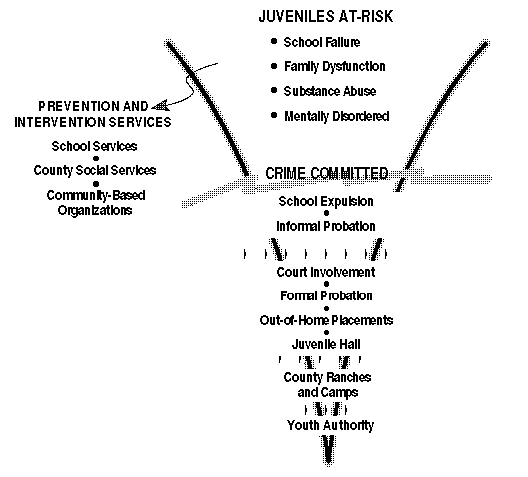
- Law enforcement and social services agencies, community-based organizations, and schools all can play a role in keeping juveniles from entering the juvenile justice system. Prevention and intervention programs can address risk factors for troubled juveniles or provide services that give young people choices other than criminal activity.
- If a juvenile commits a crime and enters the juvenile justice system, a juvenile might be handled either formally or informally, depending on the type of offense, the background of the offender, and the availability of resources.
Who Exercises Discretion in the Juvenile Justice System?
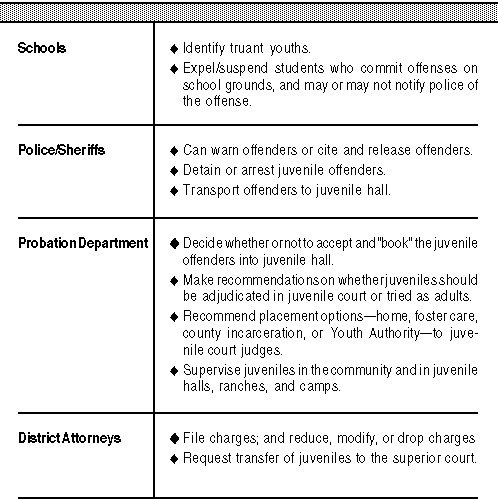
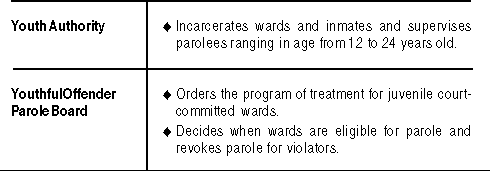
Typical Outcomes of 1,000 Juvenile Contacts With Police
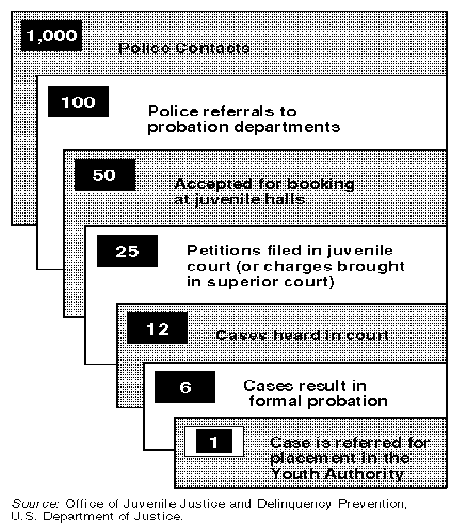
Profile of Juvenile Offenders
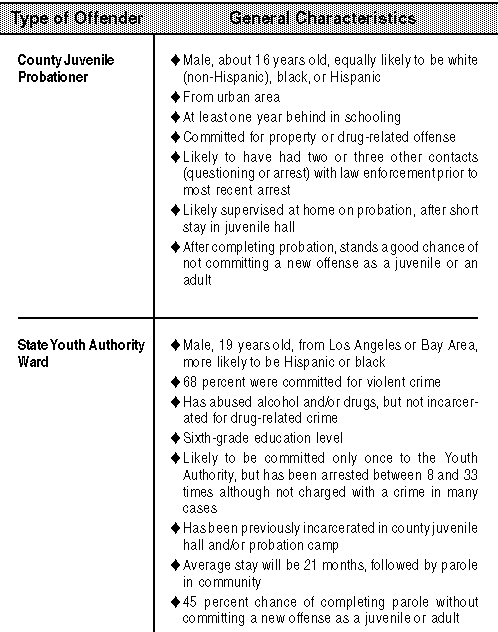
Counties With Juvenile Detention Facilities
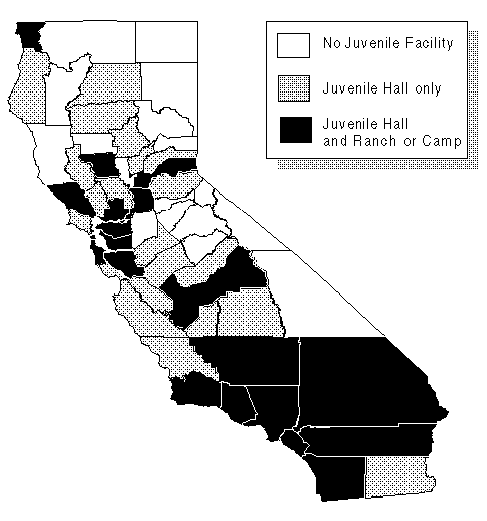
- Most counties have juvenile halls, which house offenders for an average of ten days. Those that don t have such facilities generally contract with adjacent counties for space. There are approximately 6,100 juvenile hall beds in California, almost 30 percent of these beds are in Los Angeles.
- Counties also have ranches or camps to incarcerate juveniles for longer periods, usually an average of six months. There are almost 4,000 ranch and camp beds statewide, almost 54 percent of these beds are in Los Angeles.
California Youth Authority Facilities
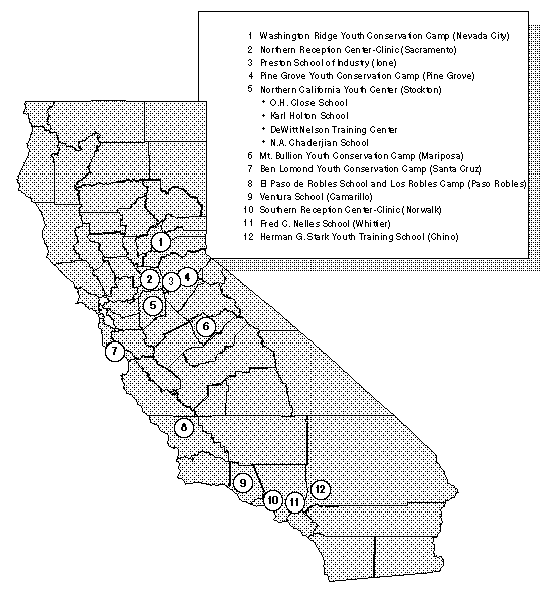
Youth Authority Institutions Are Overcrowded
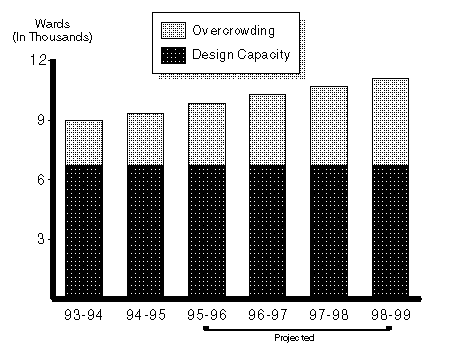
- Youth Authority institutional population is expected to grow from 9,400 wards in 1994-95 to over 10,000 in 1998-99.
- Youth Authority overcrowding is expected to increase from 147 percent in 1995-96, to over 165 percent by the end of 1998-99.
- Given the currently available facilities, overcrowding is due to two factors. The first is the growth of the state's juvenile population. The second is increasing lengths of stay by juveniles in these facilities. Lengths of stay are increasing for two reasons: (1) wards are being admitted for more serious crimes and (2) overcrowding limits the Youth Authority's ability to ensure that wards get needed program services. When a ward cannot get required program services, he or she is not paroled, thereby staying longer in youth authority facilities.
Who Is in the Youth Authority?
June 30, 1994
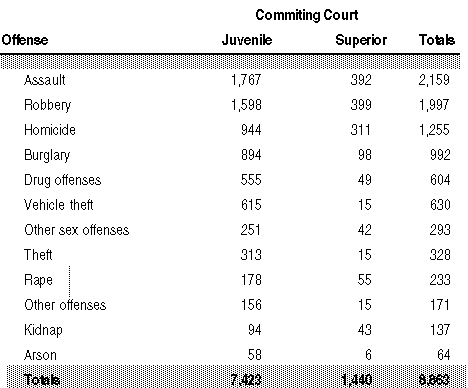
- Over 68 percent of the Youth Authority population have been incarcerated for violent offenses, over 14 percent for homicide.
- About 23 percent of Youth Authority wards have been incarcerated for property offenses.
Most Youth Authority Wards Are Older Than Age 17
June 30, 1994
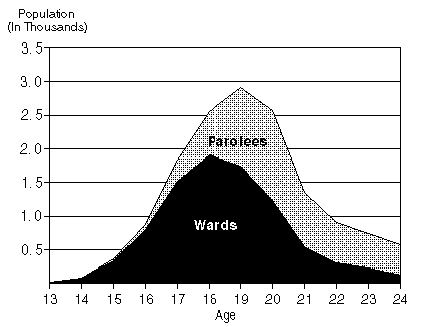
- Almost 70 percent of the Youth Authority's incarcerated population is between 18 and 24 years old, and consequently are adults. Over 92 percent of Youth Authority parolees are over age 17.
- In 1993, for the wards admitted to the Youth Authority, the average age of a juvenile court commitment was 16.4 years old. For Department of Corrections inmates placed in the Youth Authority, the average age at first admission was 19.3 years old.
Return Juvenile Crime Table of Contents
Visit the 2007 Publication, California’s Criminal Justice
System: A Primer
Return to LAO Home Page